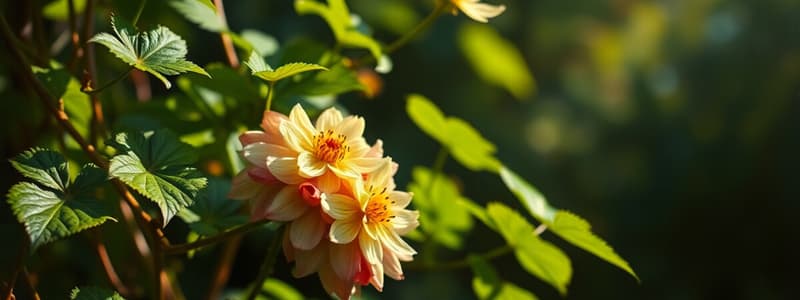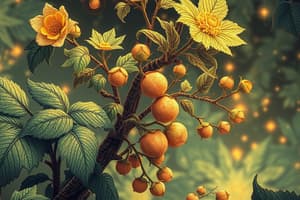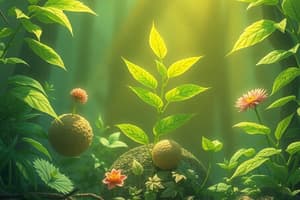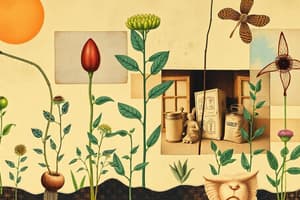Podcast
Questions and Answers
The components of food that are necessary for our body are called ______.
The components of food that are necessary for our body are called ______.
nutrients
The mode of nutrition in which organisms make food themselves from simple substances is called ______ nutrition.
The mode of nutrition in which organisms make food themselves from simple substances is called ______ nutrition.
autotrophic
Animals and most other organisms take in food prepared by plants and are called ______.
Animals and most other organisms take in food prepared by plants and are called ______.
heterotrophs
The cell is enclosed by a boundary called the ______.
The cell is enclosed by a boundary called the ______.
Most cells have a distinct, centrally located spherical structure called the ______.
Most cells have a distinct, centrally located spherical structure called the ______.
The nucleus is surrounded by a jelly-like substance called ______.
The nucleus is surrounded by a jelly-like substance called ______.
The pores on the surface of leaves, surrounded by guard cells, are called ______.
The pores on the surface of leaves, surrounded by guard cells, are called ______.
The green pigment in leaves that helps capture sunlight energy is called ______.
The green pigment in leaves that helps capture sunlight energy is called ______.
The process by which plants synthesize food using sunlight is called ______.
The process by which plants synthesize food using sunlight is called ______.
During photosynthesis, chlorophyll containing cells of leaves use carbon dioxide and water to synthesize ______.
During photosynthesis, chlorophyll containing cells of leaves use carbon dioxide and water to synthesize ______.
Plants can synthesize proteins and vitamins because soil has certain bacteria that convert gaseous nitrogen into a ______ form.
Plants can synthesize proteins and vitamins because soil has certain bacteria that convert gaseous nitrogen into a ______ form.
Plants that do not have chlorophyll use the ______ mode of nutrition and depend on food produced by other plants.
Plants that do not have chlorophyll use the ______ mode of nutrition and depend on food produced by other plants.
The plant on which Cuscuta climbs and takes readymade food from is called the ______.
The plant on which Cuscuta climbs and takes readymade food from is called the ______.
Insect-eating plants that trap insects and digest them are called ______ plants.
Insect-eating plants that trap insects and digest them are called ______ plants.
Organisms that take in nutrients from dead and decaying matter exhibits ______ nutrition.
Organisms that take in nutrients from dead and decaying matter exhibits ______ nutrition.
Flashcards
What are nutrients?
What are nutrients?
Components of food that are necessary for our body.
What is autotrophic nutrition?
What is autotrophic nutrition?
The mode of nutrition where organisms make food themselves from simple substances.
What are heterotrophs?
What are heterotrophs?
Organisms that obtain food prepared by other plants.
What are cells?
What are cells?
Signup and view all the flashcards
What is the cell membrane?
What is the cell membrane?
Signup and view all the flashcards
What is the nucleus?
What is the nucleus?
Signup and view all the flashcards
What is cytoplasm?
What is cytoplasm?
Signup and view all the flashcards
What are stomata?
What are stomata?
Signup and view all the flashcards
What is chlorophyll?
What is chlorophyll?
Signup and view all the flashcards
What is Photosynthesis?
What is Photosynthesis?
Signup and view all the flashcards
What is the sun?
What is the sun?
Signup and view all the flashcards
What are saprotrophs?
What are saprotrophs?
Signup and view all the flashcards
What is symbiosis?
What is symbiosis?
Signup and view all the flashcards
What are lichens?
What are lichens?
Signup and view all the flashcards
What is Rhizobium?
What is Rhizobium?
Signup and view all the flashcards
Study Notes
Nutrition in Plants
- Food is essential to all living organisms.
- Carbohydrates, proteins, fats, vitamins, and minerals are components of food.
- Nutrients are necessary for our body.
Modes of Nutrition
- Plants can create their own food while humans and animals cannot.
- Humans and animals rely on plants for food, either directly or indirectly.
- Nutrition is the process of taking food and how the body uses it.
- Autotrophic nutrition: Organisms make their own food, plants are autotrophs.
- Heterotrophic nutrition: Animals obtain food prepared by plants, they are called heterotrophs.
Photosynthesis
- Water and minerals are absorbed by roots and transported to leaves.
- Carbon dioxide is taken in from the air through tiny pores on the surface of leaves called stomata.
- Stomata are surrounded by guard cells.
- Cells are tiny units that make up living organisms and can only be seen under a microscope.
- Cells consist of a cell membrane, nucleus, and cytoplasm.
- Chlorophyll is a green pigment in leaves that captures energy from sunlight.
- Photosynthesis uses captured sunlight energy to synthesize food from carbon dioxide and water.
- Chlorophyll, sunlight, carbon dioxide, and water are necessary for photosynthesis.
- Solar energy is captured by leaves and stored as food in the plant.
- The sun is the ultimate source of energy for all living organisms.
- Oxygen is produced during photosynthesis
- Starch in leaves indicates photosynthesis has occurred, starch is a carbohydrate.
- Photosynthesis also occurs in green stems and branches.
- Desert plants have scale or spine-like leaves to reduce water loss, with green stems to carry out photosynthesis.
- Carbohydrates are made of carbon, hydrogen, and oxygen, and used to synthesize proteins and fats.
- Nitrogen is present in the air, plants cannot absorb it in the gaseous form.
- Soil contains bacteria to convert gaseous nitrogen into a usable form.
- Farmers add fertilizers rich in nitrogen to the soil.
Other Modes of Nutrition
- Some plants lack chlorophyll and cannot synthesize food and depend on other plants
- Heterotrophic mode of nutrition: organisms depend on food produced by other plants
- Cuscuta (Amarbel): a plant without chlorophyll, that takes readymade food from a host plant.
- A host is the plant which Cuscuta climbs, depriving it of valuable nutrients, Cuscuta is a parasite.
- Insectivorous plants trap and digest insects for nutrition
- Inside the pitcher, hairs are directed downwards, trapping insects.
- Digestive juices break down the insect, and such plants are called insectivorous plants.
Saprotrophs
- Fungi are organisms that obtain nutrition from dead and decaying matter (saprotrophic nutrition).
- Saprotrophs are fungi that grow on pickles, leather, and clothes and are saprotrophic.
- Fungi spores are present in the air and grow in warm, wet conditions.
Replenishing Nutrients in the Soil
- Farmers add manure or fertilizers to fields and lawns to replenish nutrients in the soil.
- Plants absorb minerals and nutrients from the soil, depleting their amounts.
- Fertilizers and manures contain nutrients like nitrogen, potassium, and phosphorus.
- Crop plants absorb a lot of nitrogen, and the soil becomes deficient in nitrogen.
- Nitrogen gas is available in the air, plants need it in a soluble form.
- Rhizobium bacterium converts atmospheric nitrogen into a usable form.
- Rhizobium lives in the roots of legumes like gram, peas, moong, and beans.
- Rhizobium provides nitrogen, and the plants provide food and shelter.
- Symbiosis is the relationship where organisms live together and share shelter and nutrients.
- Leguminous plants reduce the need for nitrogenous fertilizers.
- Most plants are autotrophs
- A few plants are parasitic or saprotrophic.
- Animals are heterotrophs
- Insectivorous plants are partial heterotrophs.
- Lichens consist of a fungi and algae living together
- The algae is a chlorophyll-containing partner in lichens
- Fungi provide shelter, water, and minerals to the alga
- The alga prepares and provides food to the fungus.
Studying That Suits You
Use AI to generate personalized quizzes and flashcards to suit your learning preferences.




